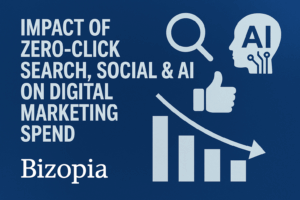The rise of zero-click search, social media dominance, and AI-driven answers is reshaping how digital marketing dollars are spent. Be on the lookout for how these situations can negatively impact digital marketing spend.
How Zero-Click Search is Affecting Marketing Spend:
1. Zero-Click Search (Google, Bing, etc.)
-
Reduced website traffic: Search engines are increasingly providing answers directly in SERPs (featured snippets, knowledge panels, People Also Ask, and AI Overviews). This means users don’t need to click through to websites.
-
Higher ad reliance: As organic clicks drop, businesses may feel forced to increase paid search budgets to maintain visibility.
-
Diminished ROI for SEO: Investments in SEO still build brand authority, but the traffic yield per dollar spent is shrinking in zero-click verticals.
 2. Social Media Platforms
2. Social Media Platforms
-
Walled gardens: Platforms (TikTok, Instagram, Facebook, LinkedIn) keep users inside their apps. Outbound link reach is down, reducing referral traffic.
-
Increased paid placement costs: Organic reach is throttled, so advertisers must pay to play. Rising CPMs mean more spend is required just to maintain the same audience share.
-
Fragmentation of spend: Marketers spread budgets thin across multiple platforms to stay relevant, diluting impact.
3. AI-Driven Experiences
-
Generative AI answers: Tools like ChatGPT, Perplexity, and Google’s AI Overviews are reducing the need for traditional search clicks. If AI summarizes a brand’s content, the user may never reach the actual site.
-
Attribution challenges: AI referrals aren’t always trackable (dark funnel). This makes it harder to tie spend back to conversions, risking wasted budget.
-
Increased competition for “training data visibility”: Brands may need to optimize for AI answer engines in addition to Google, requiring new investments in schema, structured content, and specialized SEO.
4. Negative Impacts on Spend Efficiency
-
Higher acquisition costs: As clicks move behind ads and AI walls, CAC (Customer Acquisition Cost) goes up.
-
Content cost inflation: To compete, brands invest more in multimedia, AI-optimized, and platform-native content — raising production budgets without proportional increases in ROI.
-
Shift from owned to rented channels: Budgets shift away from websites/email (owned assets) toward ad ecosystems (Google, Meta, TikTok), where margins are thinner.
5. Strategic Implications
-
Digital marketers may spend more but own less of the funnel.
-
Short-term budgets tilt toward ads, while long-term ROI drops as organic reach erodes.
-
Attribution gaps could lead to overspending in channels that “look” good on reports but aren’t driving true conversions.
Ways to Increase Efficiency of Marketing Spend
Zero-click search, social, and AI don’t necessarily shrink marketing budgets — they make them less efficient. Businesses often spend more for the same or fewer conversions, with less control over the customer journey and the remedy isn’t to “fight” zero-click, social, and AI, but to adapt spend and strategy so efficiency improves again. Here are some core remedies:
1. Double Down on Owned Assets
-
Strengthen website value: Publish content that goes beyond “answer box” material — deeper guides, tools, downloads, and calculators that AI can’t fully replace.
-
Build email/SMS lists: Shift ad dollars toward lead capture. Even if users first interact via AI or social, pull them into channels you own.
-
Community & brand authority: Encourage branded searches and direct traffic by building loyalty and visibility off-platform.
2. Optimize for AI & Zero-Click
-
Structured data & schema: Ensure your content is machine-readable so AI assistants surface your brand in responses.
-
AI-ready content: Create concise, authoritative answers and longer in-depth resources, so your content feeds AI models while still attracting click-through.
-
Visual assets: Images, videos, and interactive elements are harder for AI or zero-click boxes to fully replicate — but great for capturing user attention.
3. Rebalance Paid Spend
-
Smarter targeting: Invest in highly qualified audiences (remarketing, lookalikes, intent-based targeting) rather than broad reach that fuels inefficiency.
-
Test new ad formats: TikTok Shop, Instagram Checkout, YouTube Shorts — meet buyers where the platform keeps them.
-
Measure incrementality: Shift budget toward channels that show true lift, not just attribution “mirages” caused by AI or social platforms.
4. Fix the Measurement Gap
-
First-party analytics: Strengthen GA4, CRM, and server-side tracking to capture what “dark funnel” tools don’t show.
-
Attribution modeling: Move away from last-click; instead, measure blended CAC, multi-touch, and long-tail effects.
-
Conversion proxies: Track micro-conversions (downloads, video views, newsletter signups) that signal intent in a zero-click world.
5. Long-Term Play: Brand as the Moat
When information is commoditized by AI, brand trust becomes the differentiator. The more recognizable and authoritative your brand, the more likely customers are to seek you out directly — bypassing AI and platform walls.
Bizopia Helps Increase the Efficiency of Marketing Spend
How can Bizopia, a Houston digital marketing agency with its finger on the pulse of today’s digital landscape, help businesses? We know we can’t keep doing the same thing and stay afloat. We can help shift spend toward owned channels, AI-optimized content, smarter paid targeting, and stronger measurement. The brands that treat AI/social as distribution channels instead of gatekeepers will spend less wastefully and preserve control of their funnel. Call us today – 832-327-3239!